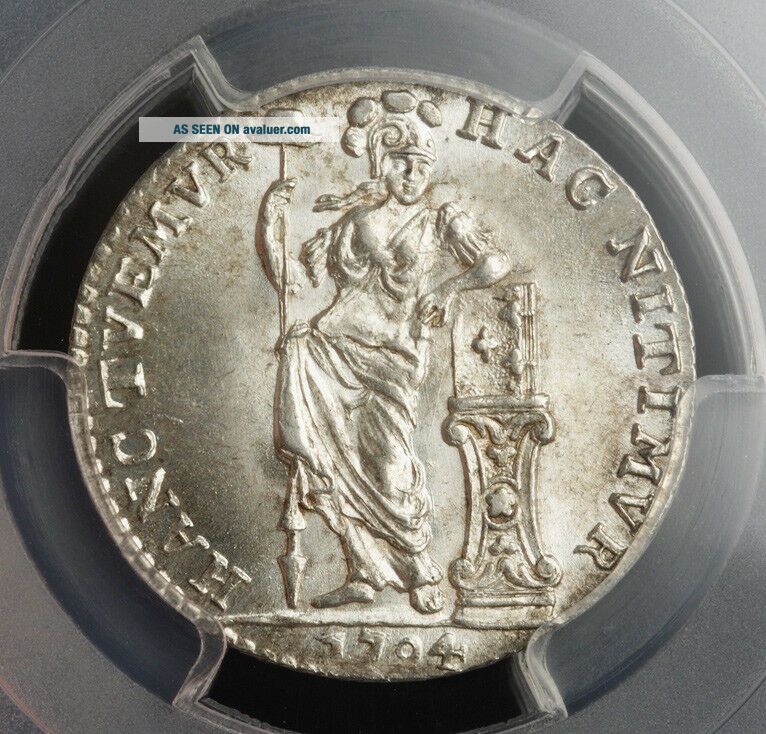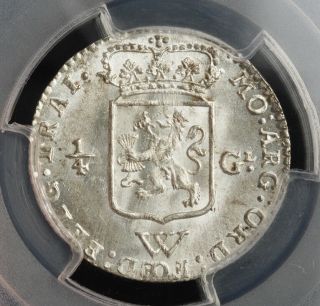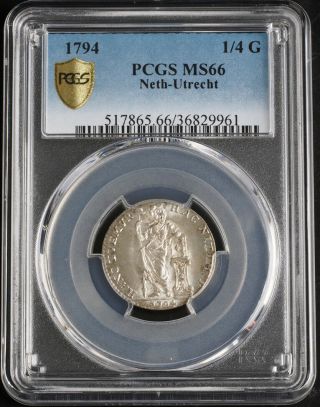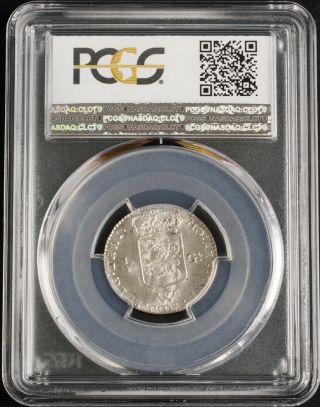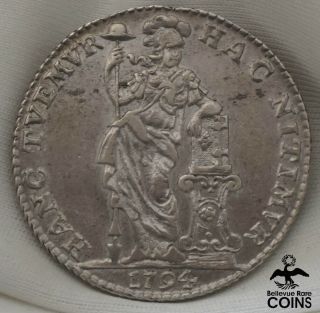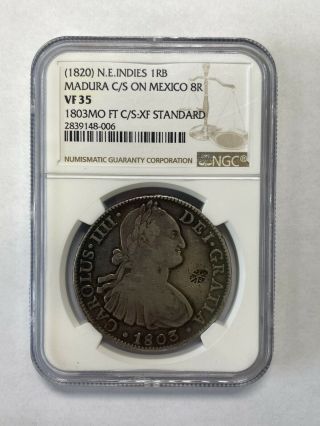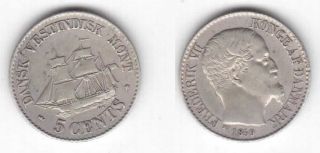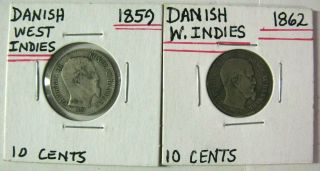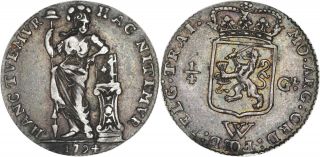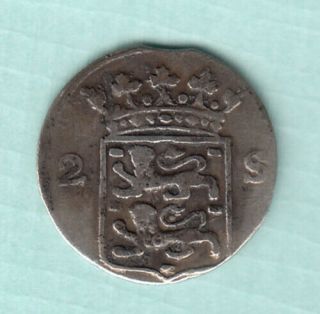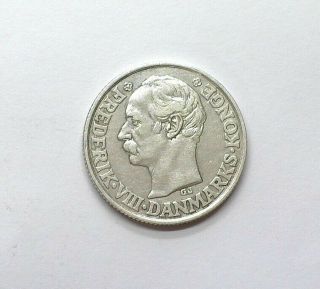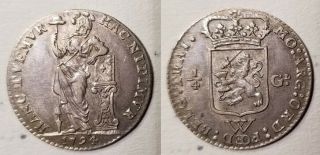1794, Netherlands West Indies. Rare Silver 1/4 Gulden Coin. Top Pop PCGS MS - 66
Item History & Price
| Reference Number: Avaluer:591686 | Composition: Silver |
| Grade: MS66 | Certification Number: 36829961 |
| Year: 1794 | Certification: PCGS |
CoinWorldTV1794, Netherlands West Indies. Rare Silver 1/4 Gulden Coin. Top Pop! PCGS MS-66!Mint Year: 1794
State: Netherlands
Mintage: 20, 150 pcs.
Denomination: 1/4 Gulden (5 Stuivers)
Condition: Certified and graded by PCGS as MS-66 (None equal and none higher!)
Mint Place: Utrecht (struck for circulation in the Netherlands West Indies and also listed in KM there!)
Reference: S-1355B, KM-2. Very rare in this designation without any comparable piece at PCGS and onl...y one equal at NGC!
Weight: 6.65gm
Material: SilverObverse: Standig togate personification of the Dutch Republic (Hollandia), wearing plummed helmet, holding reversed spear, topped by a hat and leaning on book, placed on a decorated column. Date (1794) below.
Legend (motto) : HANC TVEMVR - HAC NITIMVR / 1794
Translated:"This we defend, by this we strive!"Reverse: Crowned shield of the United Provinces, splitting denomination (1/4-Gl.). Cipher of the Dutch West Inda Company (W) below.
Legend: MO : ARG : ORD : FOED : BELG : TRAI .
Expanded: "MOneta ORDinum FAEDERatorum BELGicarum TRAIectum"
Translated: "Coin of government of the federation of Belgium, Utrecht (mint)"Dutch West India Company (WIC; English: Chartered West India Company) was a chartered company(known as the "WIC") of Dutch merchants as well as foreign investors. Among its founders was Willem Usselincx (1567–1647). On June 3, 1621, it was granted a charter for a trade monopoly in the Dutch West Indies by the Republic of the Seven United Netherlands and given jurisdiction over Dutch participation in the Atlantic slave trade, Brazil, the Caribbean, and North America. The area where the company could operate consisted of West Africa (between the Tropic of Cancer and the Cape of Good Hope) and the Americas, which included the Pacific Ocean and the eastern part of New Guinea. The intended purpose of the charter was to eliminate competition, particularly Spanish or Portuguese, between the various trading posts established by the merchants. The company became instrumental in the largely ephemeral Dutch colonization of the Americas (including New Netherland) in the seventeenth century. From 1624 to 1654, the WIC held Portuguese territory in northeast Brazil, but they were ousted from Dutch Brazil following fierce resistance.From 1694 until 1700, the WIC waged a long conflict against the Eguafo Kingdom along the Gold Coast, present-day Ghana. The Komenda Wars drew in significant numbers of neighbouring African kingdoms and led to replacement of the gold trade with enslaved Africans.After the Fourth Anglo-Dutch War, it became apparent that the Dutch West India Company was no longer capable of defending its own colonies, as Sint Eustatius, Berbice, Essequibo, Demerara, and some forts on the Dutch Gold Coast were rapidly taken by the British. In 1791, the company's stock was bought by the Dutch government, and on 1 January 1792, all territories previously held by the Dutch West India Company reverted to the rule of the States General of the Dutch Republic. Around 1800 there was an attempt to create a third West Indian Company, without any success.Authenticity unconditionally guaranteed. Bid with confidence!The Republic of the Seven United Netherlands (or "of the Seven United Provinces") (Republiek der Zeven Verenigde Nederlanden/Provinciën; also Dutch Republic or United Provinces in short, Foederatae Belgii Provinciae or Belgica Foederata in Latin) was a European republic between 1581 and 1795, in about the same location as the modern Kingdom of the Netherlands, which is the successor state.Before 1581, the area of the Low Countries consisted of a number of duchies, counties, and independent bishoprics, some but not all of them part of the Holy Roman Empire. Today that area is divided between the Netherlands, Belgium, Luxembourg and parts of France and Germany. The Low Countries in the 16th century roughly corresponded to the Seventeen Provinces covered by the Pragmatic Sanction of 1549 of Holy Roman Emperor Charles V.Through marriage, war or sale, these states were acquired by the Habsburg emperor Charles V and his son, king Philip II of Spain. In 1568, the Netherlands, led by William I of Orange, revolted against Philip II because of high taxes, persecution of Protestants by the government, and Philip's efforts to modernize and centralize the devolved medieval government structures of the provinces. This was the start of the Eighty Years' War.In 1579, a number of the northern provinces of the Netherlands signed the Union of Utrecht, in which they promised to support each other in their defence against the Spanish army. This was followed in 1581 by the Act of Abjuration, the declaration of independence in which the provinces officially deposed Philip II.The United Provinces first tried to choose their own lord, and they asked the Duke of Anjou (sovereign from 1581-1583) to rule them. Later, after the assassination of William of Orange (July 10, 1584), both Henry III of France and Elizabeth I of England declined the offer of sovereignty. However, the latter agreed to turn the United Provinces into a protectorate of England (Treaty of Nonsuch, 1585), and sent the Earl of Leicester as governor-general. This was not a success, and in 1588 the provinces became a Republic.Only 1$ shipping for each additional item purchased!
State: Netherlands
Mintage: 20, 150 pcs.
Denomination: 1/4 Gulden (5 Stuivers)
Condition: Certified and graded by PCGS as MS-66 (None equal and none higher!)
Mint Place: Utrecht (struck for circulation in the Netherlands West Indies and also listed in KM there!)
Reference: S-1355B, KM-2. Very rare in this designation without any comparable piece at PCGS and onl...y one equal at NGC!
Weight: 6.65gm
Material: SilverObverse: Standig togate personification of the Dutch Republic (Hollandia), wearing plummed helmet, holding reversed spear, topped by a hat and leaning on book, placed on a decorated column. Date (1794) below.
Legend (motto) : HANC TVEMVR - HAC NITIMVR / 1794
Translated:"This we defend, by this we strive!"Reverse: Crowned shield of the United Provinces, splitting denomination (1/4-Gl.). Cipher of the Dutch West Inda Company (W) below.
Legend: MO : ARG : ORD : FOED : BELG : TRAI .
Expanded: "MOneta ORDinum FAEDERatorum BELGicarum TRAIectum"
Translated: "Coin of government of the federation of Belgium, Utrecht (mint)"Dutch West India Company (WIC; English: Chartered West India Company) was a chartered company(known as the "WIC") of Dutch merchants as well as foreign investors. Among its founders was Willem Usselincx (1567–1647). On June 3, 1621, it was granted a charter for a trade monopoly in the Dutch West Indies by the Republic of the Seven United Netherlands and given jurisdiction over Dutch participation in the Atlantic slave trade, Brazil, the Caribbean, and North America. The area where the company could operate consisted of West Africa (between the Tropic of Cancer and the Cape of Good Hope) and the Americas, which included the Pacific Ocean and the eastern part of New Guinea. The intended purpose of the charter was to eliminate competition, particularly Spanish or Portuguese, between the various trading posts established by the merchants. The company became instrumental in the largely ephemeral Dutch colonization of the Americas (including New Netherland) in the seventeenth century. From 1624 to 1654, the WIC held Portuguese territory in northeast Brazil, but they were ousted from Dutch Brazil following fierce resistance.From 1694 until 1700, the WIC waged a long conflict against the Eguafo Kingdom along the Gold Coast, present-day Ghana. The Komenda Wars drew in significant numbers of neighbouring African kingdoms and led to replacement of the gold trade with enslaved Africans.After the Fourth Anglo-Dutch War, it became apparent that the Dutch West India Company was no longer capable of defending its own colonies, as Sint Eustatius, Berbice, Essequibo, Demerara, and some forts on the Dutch Gold Coast were rapidly taken by the British. In 1791, the company's stock was bought by the Dutch government, and on 1 January 1792, all territories previously held by the Dutch West India Company reverted to the rule of the States General of the Dutch Republic. Around 1800 there was an attempt to create a third West Indian Company, without any success.Authenticity unconditionally guaranteed. Bid with confidence!The Republic of the Seven United Netherlands (or "of the Seven United Provinces") (Republiek der Zeven Verenigde Nederlanden/Provinciën; also Dutch Republic or United Provinces in short, Foederatae Belgii Provinciae or Belgica Foederata in Latin) was a European republic between 1581 and 1795, in about the same location as the modern Kingdom of the Netherlands, which is the successor state.Before 1581, the area of the Low Countries consisted of a number of duchies, counties, and independent bishoprics, some but not all of them part of the Holy Roman Empire. Today that area is divided between the Netherlands, Belgium, Luxembourg and parts of France and Germany. The Low Countries in the 16th century roughly corresponded to the Seventeen Provinces covered by the Pragmatic Sanction of 1549 of Holy Roman Emperor Charles V.Through marriage, war or sale, these states were acquired by the Habsburg emperor Charles V and his son, king Philip II of Spain. In 1568, the Netherlands, led by William I of Orange, revolted against Philip II because of high taxes, persecution of Protestants by the government, and Philip's efforts to modernize and centralize the devolved medieval government structures of the provinces. This was the start of the Eighty Years' War.In 1579, a number of the northern provinces of the Netherlands signed the Union of Utrecht, in which they promised to support each other in their defence against the Spanish army. This was followed in 1581 by the Act of Abjuration, the declaration of independence in which the provinces officially deposed Philip II.The United Provinces first tried to choose their own lord, and they asked the Duke of Anjou (sovereign from 1581-1583) to rule them. Later, after the assassination of William of Orange (July 10, 1584), both Henry III of France and Elizabeth I of England declined the offer of sovereignty. However, the latter agreed to turn the United Provinces into a protectorate of England (Treaty of Nonsuch, 1585), and sent the Earl of Leicester as governor-general. This was not a success, and in 1588 the provinces became a Republic.Only 1$ shipping for each additional item purchased!



